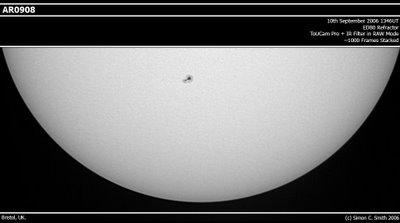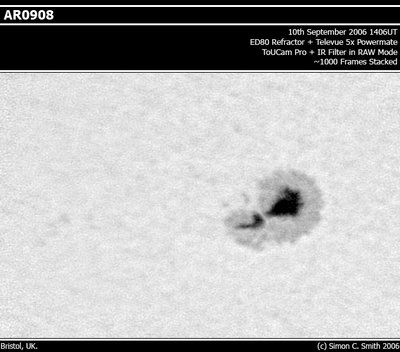AR908 & Image Scales
I've got quite a backlog of images to process, but I thought I'd do this set first as it gives a great sense of scale using my ED80 and the various optical configurations available to me.

The widefield shot utilises a Mogg focal reducer (which I bought with the webcam adaptor) which perfectly fits either the entire Sun or Moon onto the full width of the ToUCam CCD. It gives a nice overall impression of what the sun looked like visually with a low power eyepiece - though I could disern slightly more visual detail on AR909 and AR907. I do wonder why the spot between those 2 does not have a designation. The processing on this image has resulted in some unsightly edge steps around the Solar limb, so something to try to tackle in the future.

Moving on to prime focus, this was taken by letting the Solar disk slide across the CCD, always keeping AR908 on screen. Registax can then use this to align the images, and by setting the final stack to "expand" you get the entire width of the Solar disc in one go. It should be noted that all these images were "hand guided" in the sense that I had to keep slowly tweaking the RA drive knob as I recorded each of the higher magnification (x2 and x5) images. With 5fps, and over 1000 frames, that equates to 3.5 minutes and an aching arm :) I have managed to supress any limb processing artifacts on this image which is good, and the faint "noise" is actually granularity on the surface.

We now move on to using the Meade 2x Barlow lens. This shows quite a bit of detail in AR908 with a hint of filamentry structure around the edge. The granularity is quite evident here and some of the granules are much darker than others - perhaps other spots just trying to get out?

The final image was captured using my new 5x Televue Powermate. This is a stunning piece of kit of exceptional quality. Considering the ED80 is only an 80mm refractor, this is quite some image scale and the detail is there to see! The noise on the far left hand edge is due to a lack of coverage over the captured frames as it was quite difficult to keep the sunspot centered on the CCD as the mount was not correctly polar aligned resulting in some drift in DEC that does rather show itself when using image scales like this.
Next update will be on some images from my camping holiday in Cornwall where I managed to (just) visually observe Uranus ... what a night that was :)

The widefield shot utilises a Mogg focal reducer (which I bought with the webcam adaptor) which perfectly fits either the entire Sun or Moon onto the full width of the ToUCam CCD. It gives a nice overall impression of what the sun looked like visually with a low power eyepiece - though I could disern slightly more visual detail on AR909 and AR907. I do wonder why the spot between those 2 does not have a designation. The processing on this image has resulted in some unsightly edge steps around the Solar limb, so something to try to tackle in the future.

Moving on to prime focus, this was taken by letting the Solar disk slide across the CCD, always keeping AR908 on screen. Registax can then use this to align the images, and by setting the final stack to "expand" you get the entire width of the Solar disc in one go. It should be noted that all these images were "hand guided" in the sense that I had to keep slowly tweaking the RA drive knob as I recorded each of the higher magnification (x2 and x5) images. With 5fps, and over 1000 frames, that equates to 3.5 minutes and an aching arm :) I have managed to supress any limb processing artifacts on this image which is good, and the faint "noise" is actually granularity on the surface.

We now move on to using the Meade 2x Barlow lens. This shows quite a bit of detail in AR908 with a hint of filamentry structure around the edge. The granularity is quite evident here and some of the granules are much darker than others - perhaps other spots just trying to get out?

The final image was captured using my new 5x Televue Powermate. This is a stunning piece of kit of exceptional quality. Considering the ED80 is only an 80mm refractor, this is quite some image scale and the detail is there to see! The noise on the far left hand edge is due to a lack of coverage over the captured frames as it was quite difficult to keep the sunspot centered on the CCD as the mount was not correctly polar aligned resulting in some drift in DEC that does rather show itself when using image scales like this.
Next update will be on some images from my camping holiday in Cornwall where I managed to (just) visually observe Uranus ... what a night that was :)

0 Comments:
Post a Comment
<< Home